The plants in our yard thrive — without pesticides. How do we do it?
Healthy soil
In Our Edible Garden this means adding a lot of compost. In our habitat garden, though, we don’t add extra compost, but we do leave the leaves where they fall to decompose naturally. In fact, a plant’s own leaves left to decompose around it may provide the best nutrition there is.
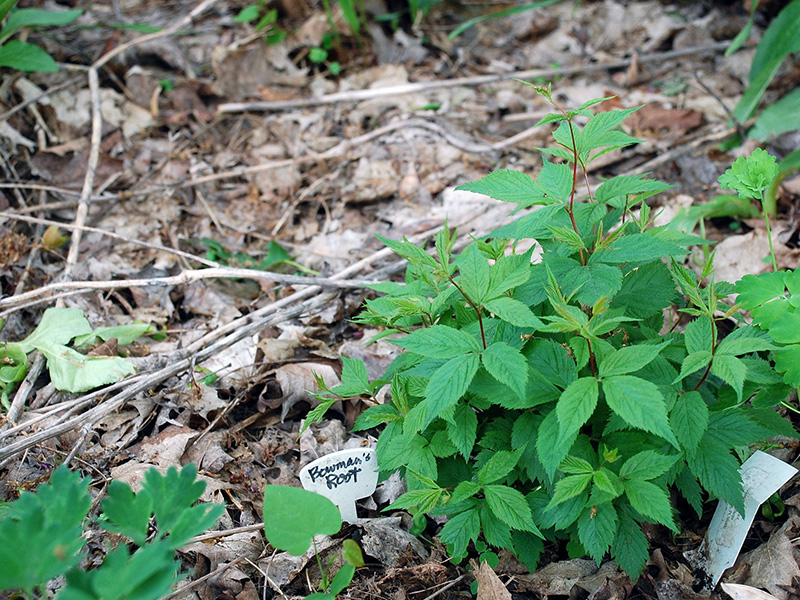
And by not using chemicals, we’re also protecting the fungi and microorganisms naturally present in healthy soil (unless pesticides and tilling have destroyed them).
The bottom line is that a healthy plant supported by healthy soil will be better able to fend off pests and diseases.
When we do have diseased plants
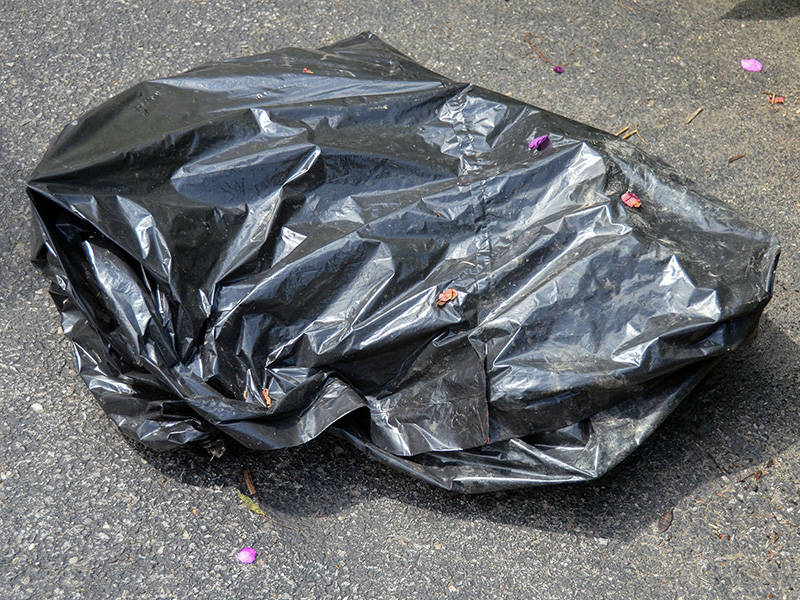
No one escapes all plant diseases! When we do suspect a diseased plant, we dispose of it in a black plastic bag we keep on the driveway. We let it “solarize” a while to cook down into smaller amounts and then put it in the trash, NOT the yard waste pickup! We certainly don’t want to spread any plant disease beyond our yard.
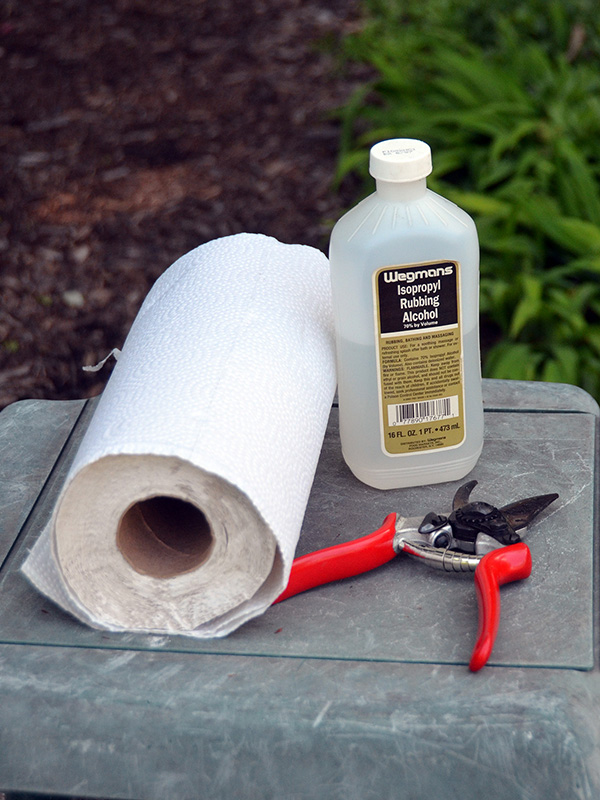
And after using pruners on any diseased plant we try to remember to sanitize the pruner blades.
Changed expectations
We also don’t expect every leaf, flower or fruit to be perfect. We wholeheartedly agree with Grissell’s perspectives (see Reflections below).

It makes life a lot easier when we don’t have to get upset about every little leaf hole.
These particular holes were intriguing. We discovered that a type of leaf cutter bee prefers redbud leaves when making its egg cells!
Very interesting and a good use of redbud leaves!
Doug Tallamy suggests that if the little gnawings on leaves bothers you, use the “Ten Step Rule.” Just take ten steps back, and it’s hard to see any damage!

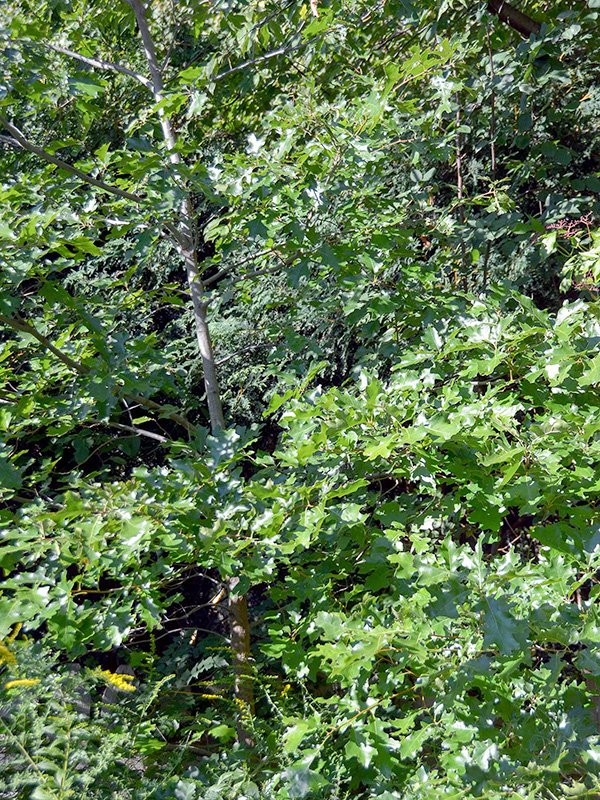
Part of the reason we can ignore many of these problems is that, on the whole, our plants are healthy. (In fact, it was difficult for me to find a photo of one of my plants with a problem!) Tallamy’s research has found that landscapes can have up to 10% of plants with leaf problems etc. before people even notice.
Still, though, some pests — especially non-native imports for which our native plants haven’t developed resistance — have to be dealt with some way. In some cases, such as with my arrowwood viburnums, we decided it was just not worth fighting the non-native viburnum leaf beetle, and we just let the plants succumb to this non-native pest.
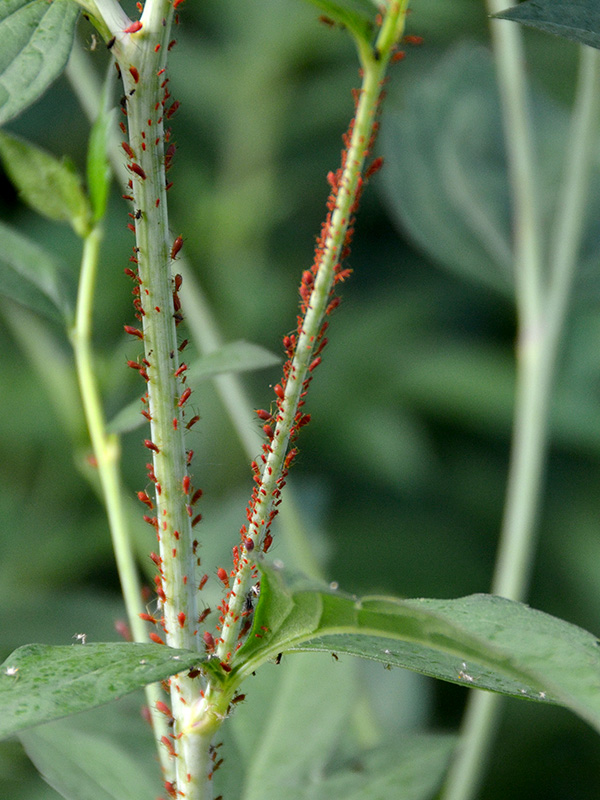
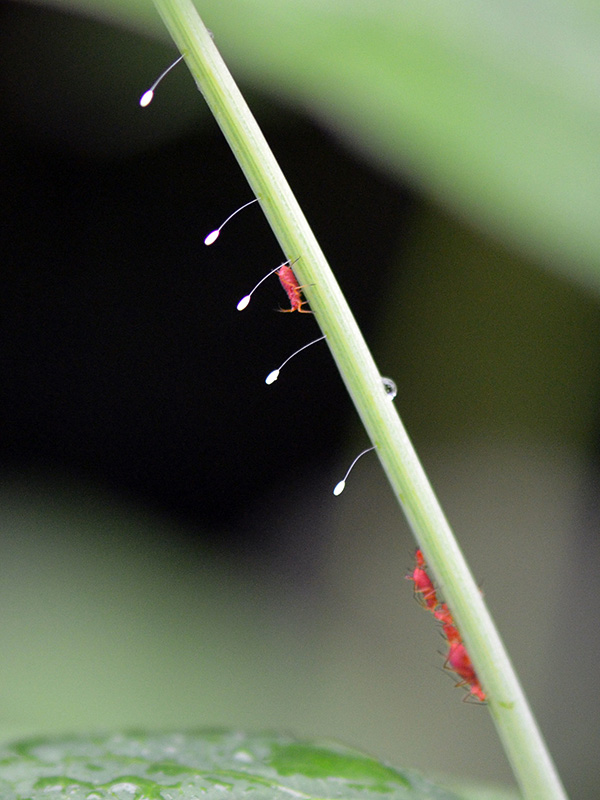
Ignoring them is always a possibility. These are (I think) brown ambrosia aphids, but whatever they are, they’re quite obvious. From what I’ve read, though, they don’t hurt the plant — and from the abundance of cutleaf coneflowers I have, I have to conclude they’re correct!
And yet, you’ll see many “remedies” for this toxic or otherwise. We hope they provide abundant food for their predators, such as ladybugs or lacewings, to feed their young. (The lacewing eggs are on their stalks ready to hatch soon.)
Hand-picking pests
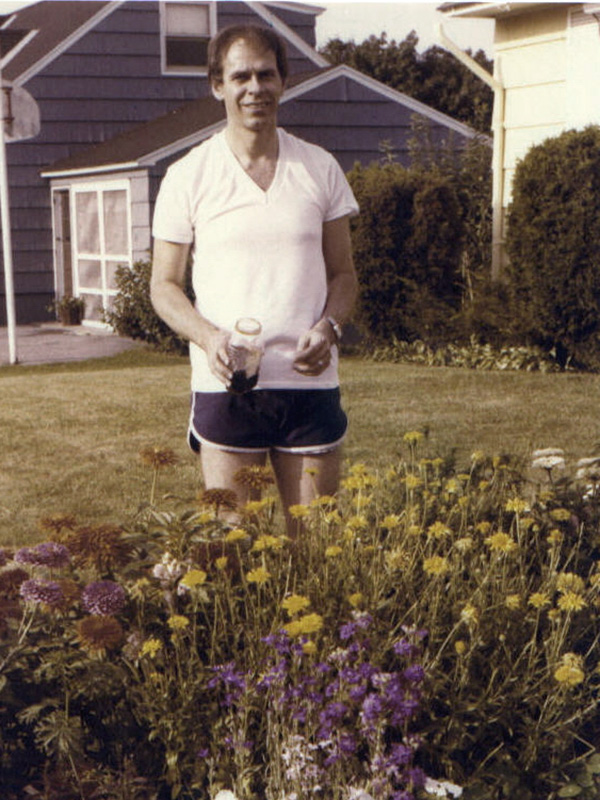
Even at our previous house, we found that hand-picking some pests was the best way to get rid of them.
Here John is standing with his jar of soapy water collecting Japanese beetles.
(This picture happens to have been taken the day before I gave birth to our first child. Nothing stands in the way of beetle collecting!)
Our Japanese beetle “trap” plants
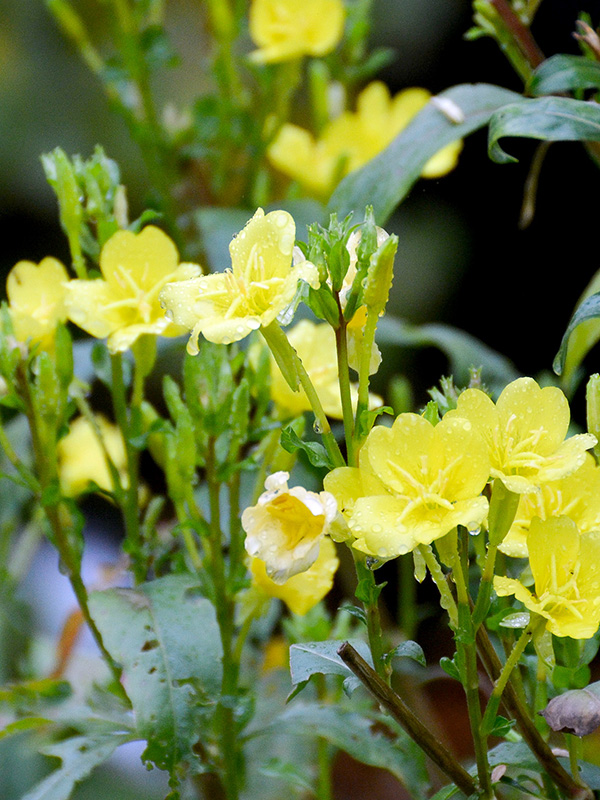
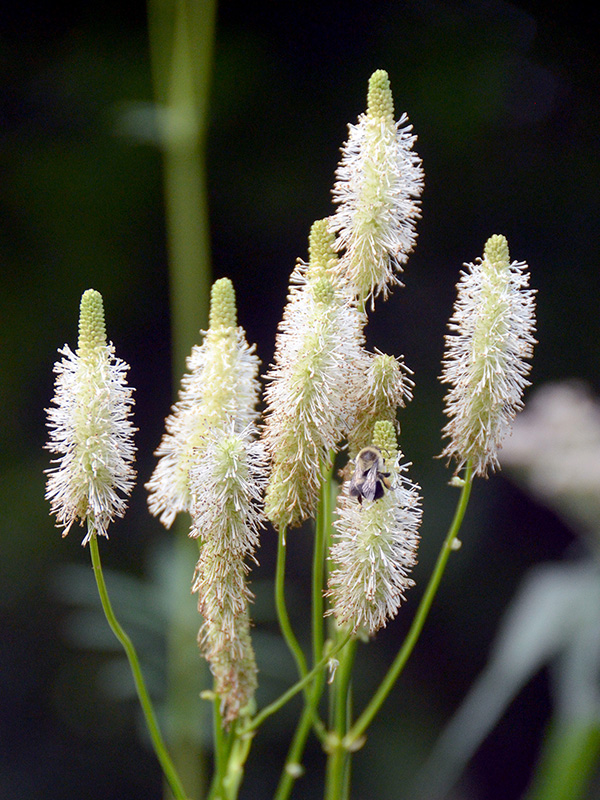
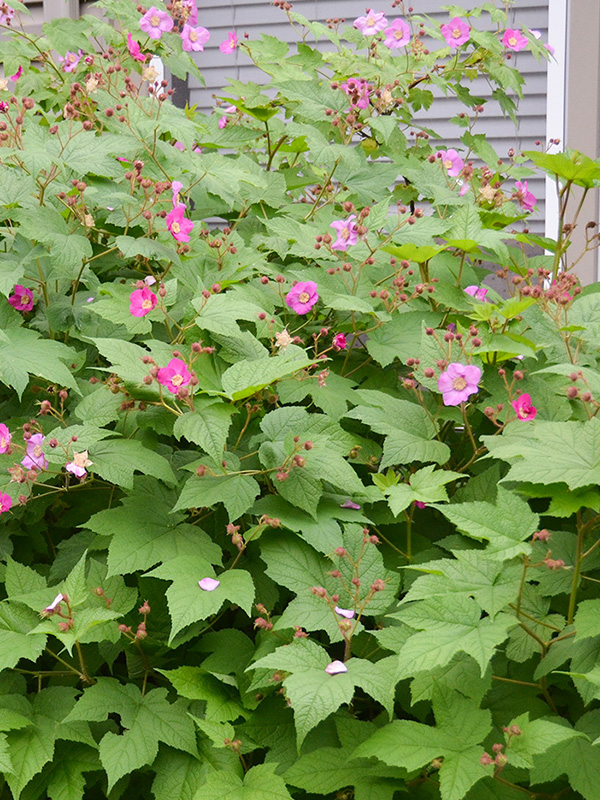
It’s handy to know which plants are the Japanese beetle’s favorites so we check there first. In our yard, some of its favorites are the biennial primrose, Canada burnet, and flowering raspberry. We’re most successful hunting them down early in the morning or in the evening when they’re less active. We hold the jar under them and brush them off the leaf, and they generally fall right into the jar. And as I’ve lost my squeamishness about this, I often just grab them and drop them in.
Years ago, when we didn’t have time to do this ourselves, we “hired” our grade school son and his friend to collect them for a penny a piece. A good deal for them and for us!
Mosquito control
We generally haven’t had a big problem with mosquitoes despite having two ponds.
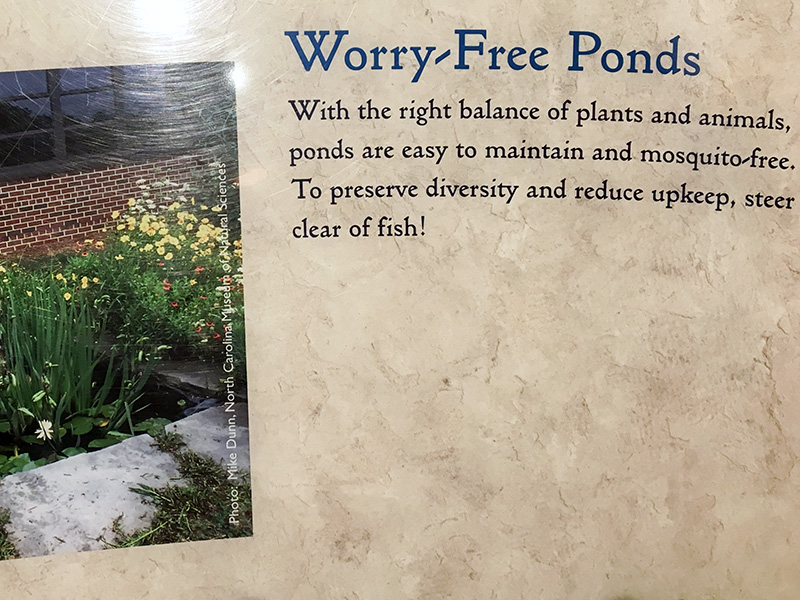
Our main pond has continually recirculating water, which prevents mosquitoes, and the other has many plants and insects.
As this sign at the Raleigh Museum of Natural Science says, ponds can indeed be mosquito-free!
PREVENTION is first
The first thing we think of when controlling mosquitoes is NOT to breed them! This means not providing standing water for them to lay eggs in.
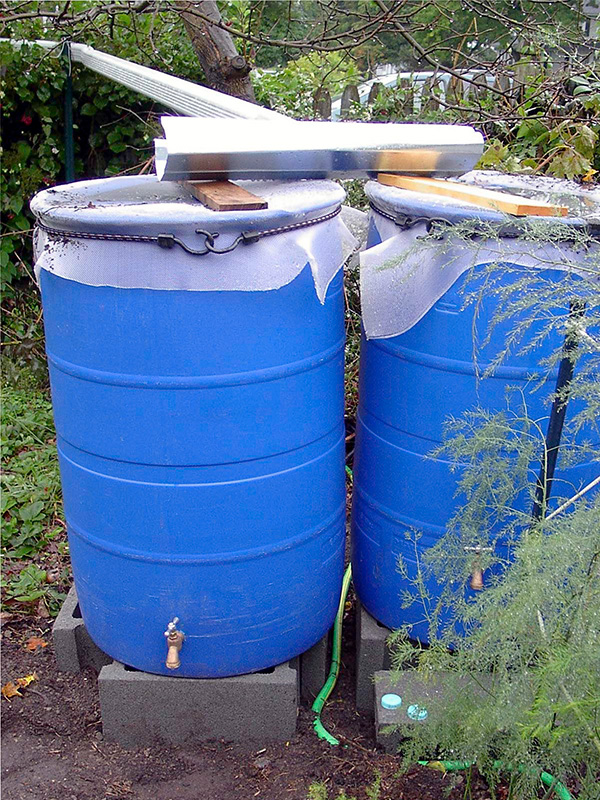
Our rain barrels are inherently places where water is “standing.” We solve this problem by covering them with window screen.
The other important thing is to eliminate less-obvious sources of standing water: upturned water jug caps, tools, clogged gutters etc.
In the past, we would have checked kids’ toys (though back then we probably didn’t).
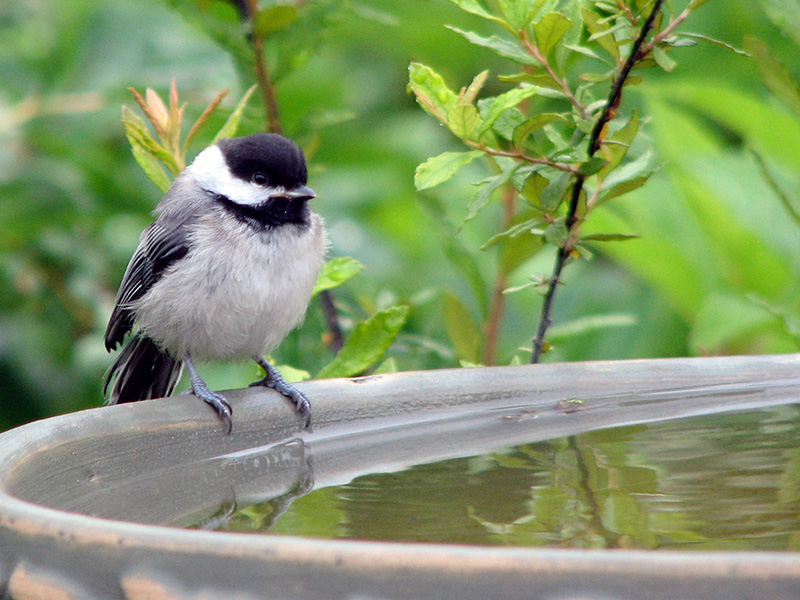
Of course, before we had our ponds, we used bird baths, which are standing water, too (though birds do rough up the water when taking their enthusiastic baths!)
It takes about a week for mosquitoes to develop into adults, so if we still had a bird bath, we’d dump the water and clean it every four or five days — but that’s important for keeping it healthy for the birds anyway.
Then take care of existing mosquitoes
We haven’t had much of a mosquito problem, but we’re trying out Doug Tallamy’s remedy for mosquitoes. (I’ve also seen this method called “The Bucket of Doom.”) The idea is to get rid of mosquitoes in your yard not by spraying for the adult mosquitoes (killing lots of other things in the process) but by killing the mosquito larvae in a way that doesn’t harm other insects. But how do you get the mosquito larvae in one place to kill them? Here’s how we’re implementing Tallamy’s method:
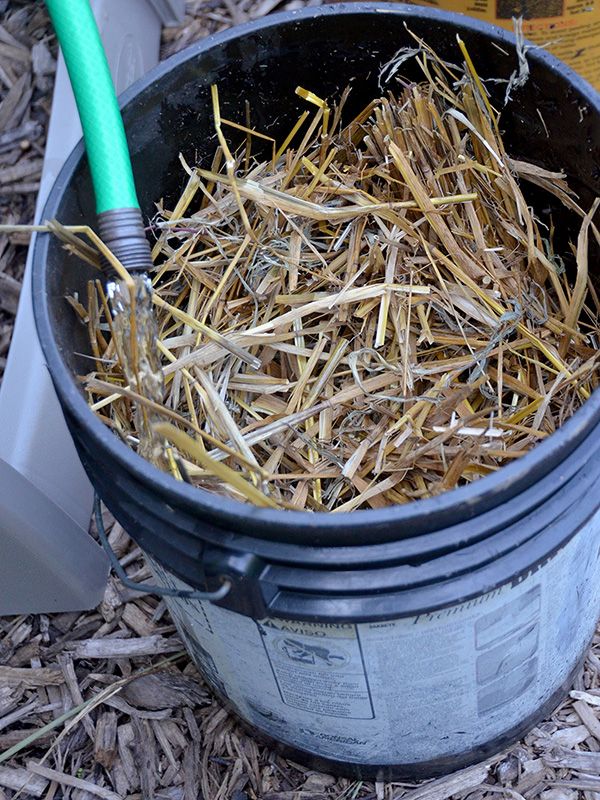
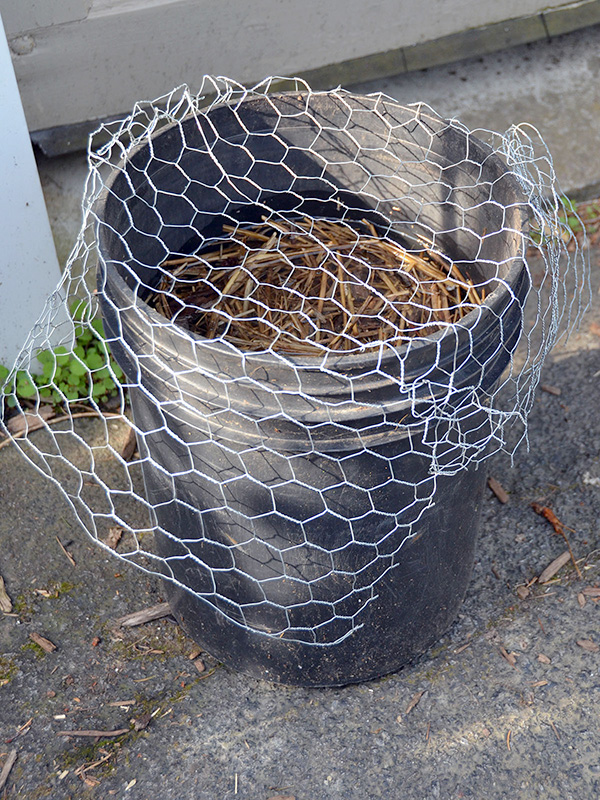
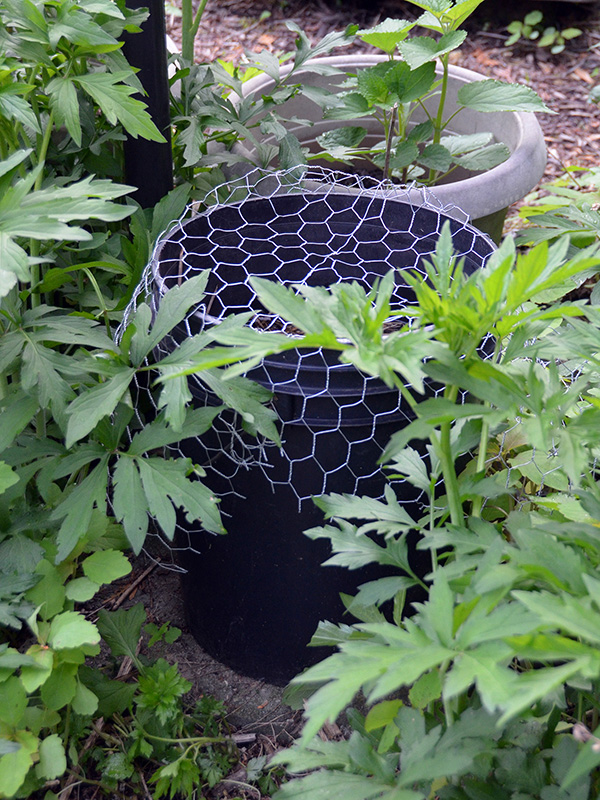
We filled two buckets with straw, added water, and waited a few days for it to ferment. Then when it smelled fermented (and it will!), we removed the straw. (I’m not sure we should remove the straw; we’ll have to check into this further …)
NOTE: This fermented water seemed to attract birds, so we added a piece of chicken wire over the bucket so the birds couldn’t fall in. Not window screen, of course, since that would keep the mosquitoes out!
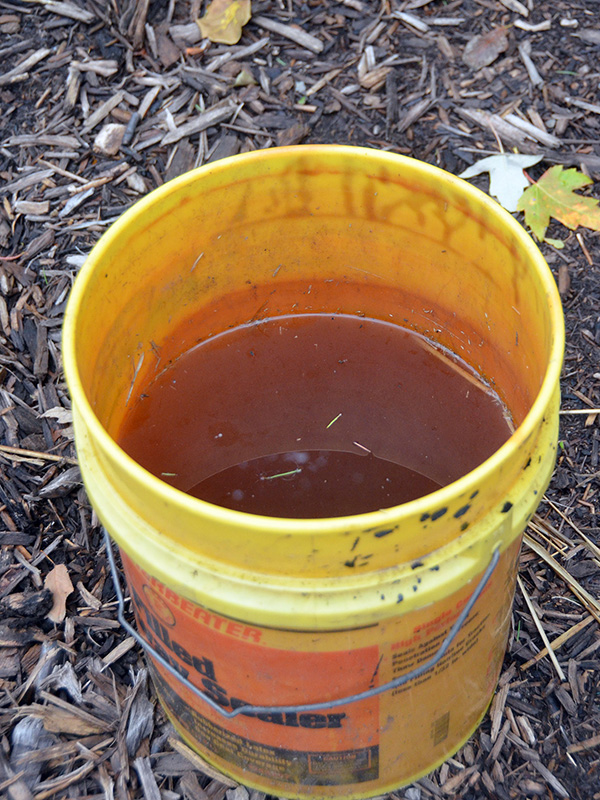
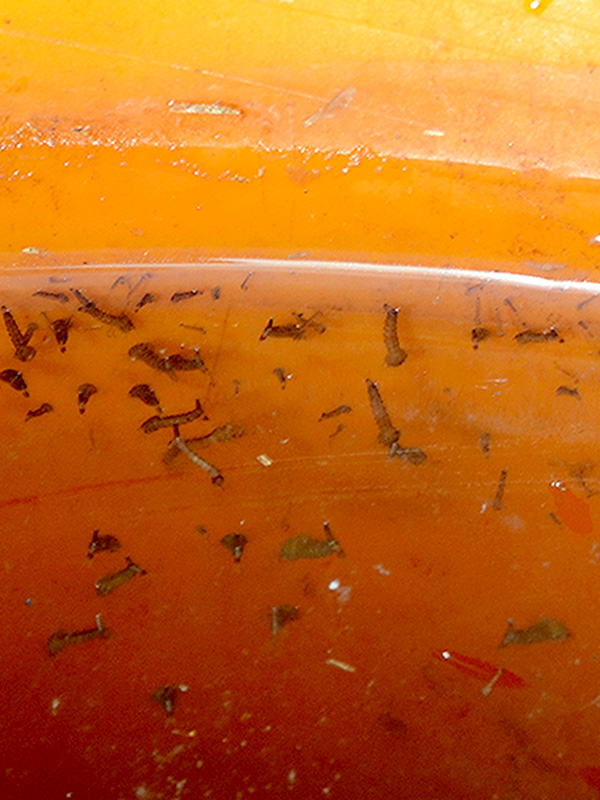
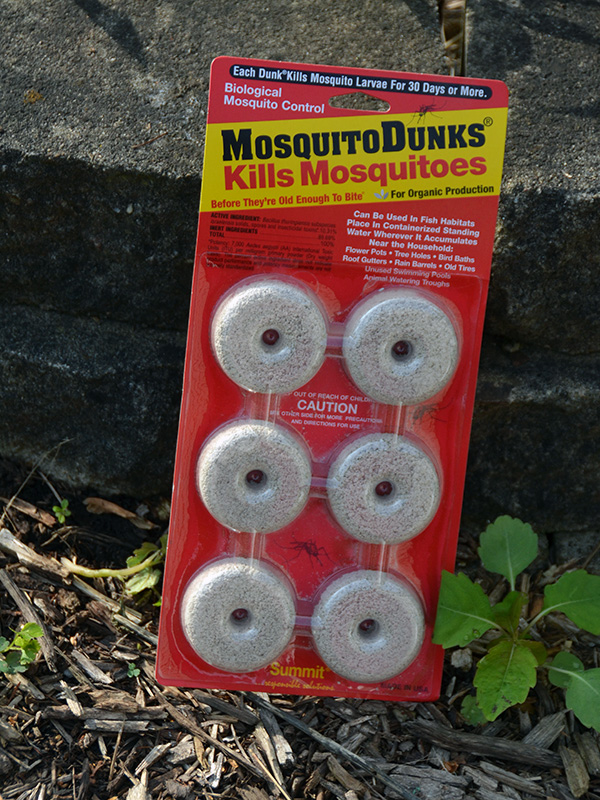
The idea is that the fermented elixir attracts the mosquitoes to lay their eggs. With such a small area, we added just a quarter of a mosquito dunk (Bt) to the bucket to kill the larvae.
Success! In other words, our bucket of fermented liquid attracted mosquitoes, they laid eggs, and they developed into larvae.
Then the mosquito dunk killed the larvae! No adults!! IMPORTANT: Remember to add a new mosquito dunk each month! They don’t last forever.
We’ll replace this with new materials in a month.
NOTE: Here’s a variation of this method that may suit your needs.
Soap
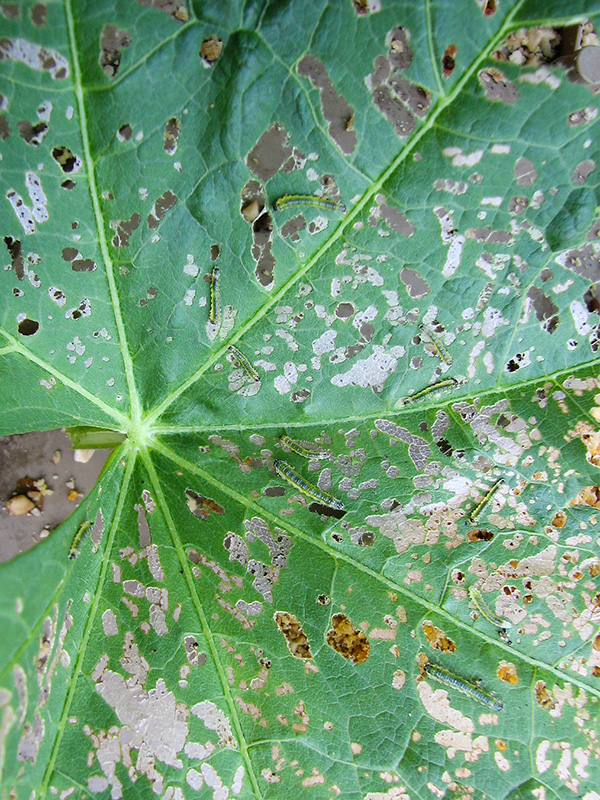
The first time I saw these hibiscus sawflies (look closely and you’ll see quite a few), they had turned my glade mallow leaves into lace seemingly overnight. It was at the end of the season, so I didn’t pay too much attention. The next year, though, they did the same thing even before it was blooming.
I thought I had found the solution: diluted Dr. Bronner’s soap. We sprayed it on the critters, and they curled up and died!
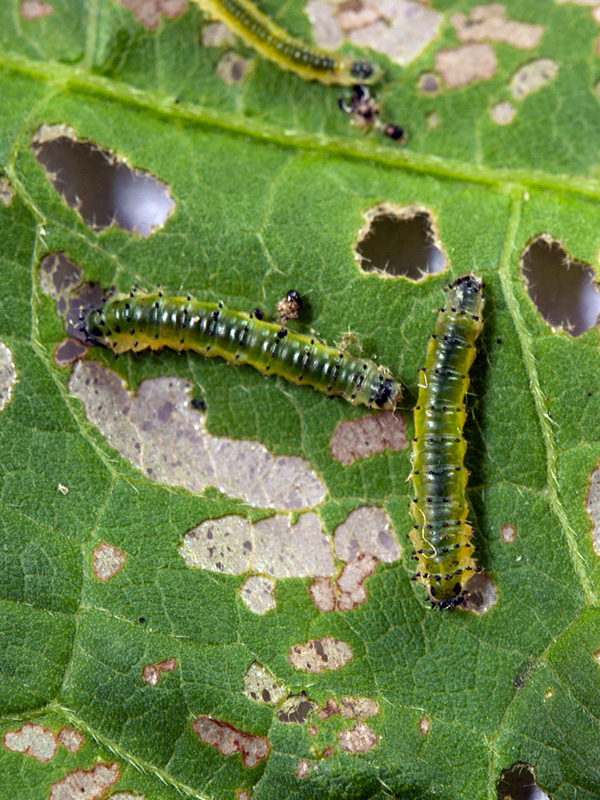
Later I learned that this isn’t such a great solution. It will harm the leaves and kill other beneficial creatures.
Besides, by then, I also better appreciated the role of insects in the garden as food for birds and other creatures.
I generally don’t bother with this problem any more (at least for native insects). I gave up on the glade mallow, and they didn’t seem to eat the leaves of the hibiscus.

UPDATE: Did they actually kill the plant? I transplanted it, and it initially did well in its new location. We still have some problems with it, though.
Organic pesticides and herbicides?
“Organic” means that the pesticide/herbicide is plant-based. But simply because a product is plant-based and/or organic doesn’t mean it’s safe. After all, if they didn’t kill their intended objects they wouldn’t be used.
Lots of organic products are available and claim to be safe and effective, but we haven’t used any of them. I’d rather create a healthy environment in my yard, and then let plants fend for themselves. If a plant dies, so be it. I’ll replace it with something that is better able to survive on its own before I get involved in these complications.
Bug zappers
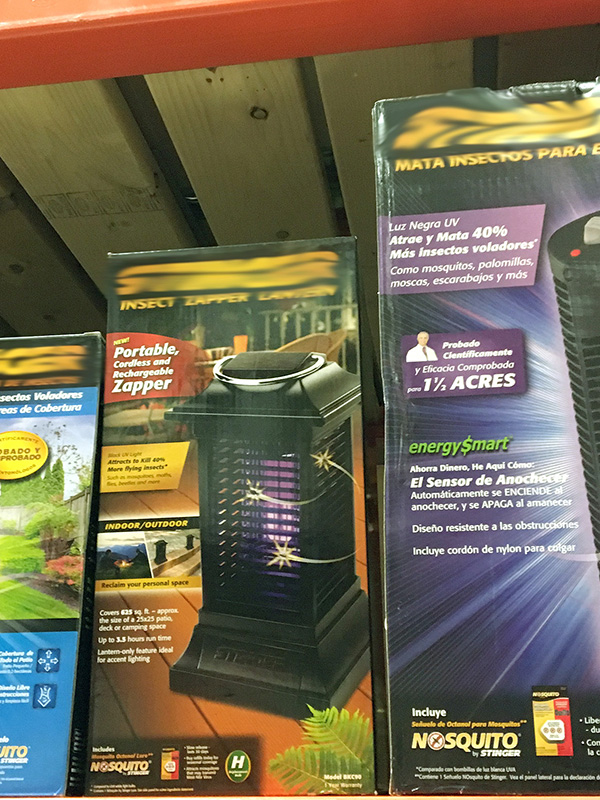
Please don’t use bug zappers!
At first, zappers may seem to be a non-chemical way to rid your yard of insects (an idea itself that is incompatible with a healthy planet!). HOWEVER, they’ve been shown to be ineffective against mosquitoes, and they kill many beneficial insects instead.
Over the US, it was estimated that the 4 million zappers in use killed about 71 BILLION harmless and beneficial insects, but only a few kinds of biting insects.
Not to mention the constant bug-zapping noise driving the neighbors crazy — and WE were the neighbors whose summer evenings were ruined by a former neighbor’s zapper!
If that didn’t dissuade anyone from using these, it has been found that the mist of dead airborne insect parts created by bug zappers can actually harm people’s health. And besides … YUCK!!!
An excerpt from the NYTimes/Wirecutter article (in Resources):
“According to the Delaware study, the zapped bugs include ‘many thousands of nontarget insects representing a rich taxonomic diversity.’ This unfocused insect elimination is so extreme that, according to the authors of the University of Delaware study, ‘Even if targeted biting flies were effectively controlled by electric zappers, the resulting destruction of thousands of parasitoids, predators, aquatic insects, and other members of the nocturnally active fauna would be difficult to justify.‘”
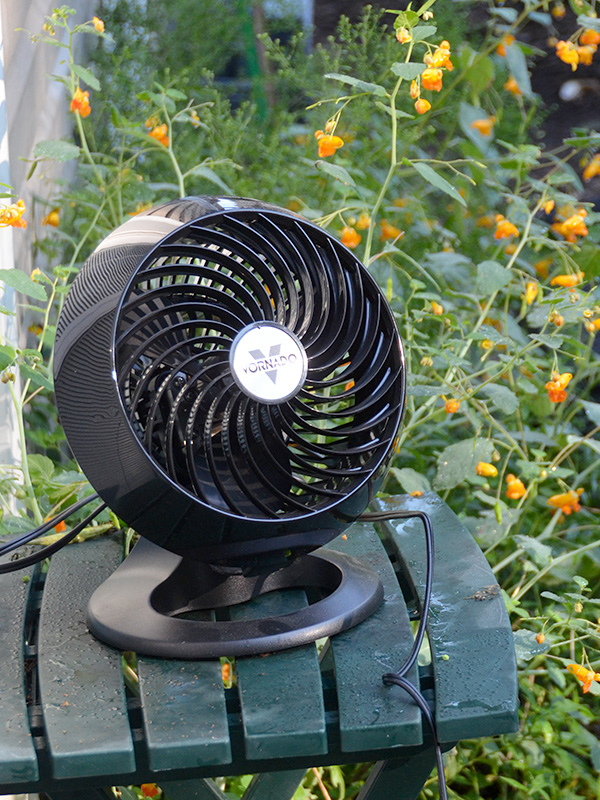
Tallamy recommends a better choice to be able to enjoy some time outside without mosquitoes: a simple fan to blow them away from your sitting area!
Resources
Mosquito control
- Homegrown National Park:
- VIDEO: Here’s the best way to kill mosquitoes instead of fogging – 1-min YouTube
- Garden Rant:
- Mosquito control – Is there really such a thing? – Success with Tallamy’s method (described above)!
- Choose Natives:
- Easy mosquito larva trap – a variation of Tallamy’s method
- NY Times:
- UNC Charlotte Urban Institute:
- Audubon: Amos Butler chapter:
- Washington State Dept. of Health:
- Sierra Club:
- National Wildlife Fed’n:
Other pesticide-related resources
- Xerces Society:
- Supporting ecologically sound mosquito management
- Mosquito management at home
- Tips for organic site preparation before you plant – describes large projects, but the concepts could apply to smaller home-based projects, too
- Science Daily:
- NY Times / Wirecutter:
- Cornell Lab of Ornithology’s All About Birds:
- RATS (Raptors are the Solution):
- Raptors are the solution – Rat poison kills eagles and owls and even family pets. There are other ways to get rid of rats.
- Univ. of Maryland Extension:
Reflections
In fact, insects are evolving resistance to chemicals just about as fast as we humans can devise new ones. Perhaps the greatest of all celestial ironies is being played out. As we increasingly risk our own health in a war of toxic terror — a process of unnatural selection — we are encouraging insects to become ever more dominant life-forms.
~ Eric Grissell, Insects and Gardens, p. 115
It is ironic to think that man might determine his own future by something so seemingly trivial as the choice of an insect spray.
~ Rachel Carson
The human race is challenged more than ever before to demonstrate our mastery, not over nature but of ourselves.
~ Rachel Carson, Silent Spring
Oppose mindless mosquito spraying by your township or HOA. Contrary to what the fogger operator may have told you, the pyrethroid-based insecticides used by mosquito foggers indiscriminately kill all insects, not just the mosquitoes. Ironically, targeting adult mosquitoes is the worst and by far the most expensive approach to mosquito control, because mosquitoes are best controlled in the larval stage.
~ Doug Tallamy, Nature’s Best Hope, p. 210
